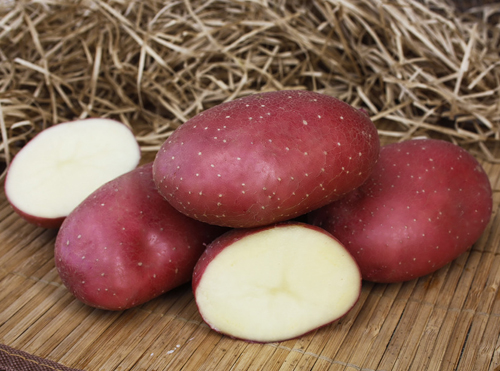Potato variety Lighthouse
Lighthouse is a medium-early variety of potatoes (Solanum tuberosum) for table use. Bred by the staff of the Ural Research Institute of Agriculture. In 2013, 4 years after filing an application for admission, it was included in the state register of breeding achievements of the Russian Federation. Zoned in the Volga-Vyatka region (Kirov, Nizhny Novgorod, Sverdlovsk regions, Perm Territory, the Republic of Mari El, Udmurt and Chuvash). Differs in multitubing, the ability to adapt to any soil and climate. Especially popular on small garden plots.
From the emergence of full shoots to harvest, 75-85 days pass.
Medium or tall plant, intermediate type. Stems are strong, semi-erect. Leaves are medium in size, dark green, sometimes lighter in color. Medium waviness is noticeable at the edges of the leaf plate. Corollas are large, the anthocyanin coloration of their inner side is of medium intensity. The flowers are light lilac.

Potatoes have a well-developed root system, 12-18 tubers can form on one plant, with an average weight of 97-153 grams each. Oval tubers. The peel is red. The cut flesh is white in color. The eyes are very small, superficial, and inconspicuous.
The lighthouse showed itself excellently during state tests. The marketable yield of the variety was noted at the level of 117−393 c / ha, which is at the level and 150 c / ha more than the standard Nevsky... The maximum amount was harvested in the Perm Territory - 401 centners of potatoes were obtained from one hectare, which is 167 centners / ha higher than the established standards. The patent holder LLC "Agrofirma Sedek" declares that the potential yield can reach 450-500 kg / ha. Marketability is at a high level - 88-91%, keeping quality is excellent - 96%.
The taste is very good. The tubers are poorly boiled, they are suitable for preparing any dishes, except perhaps for mashed potatoes. Especially suitable for frying, deep-fried, including cooking in "uniform" or peeled, baking, stuffing. Also tubers are a great addition to salads, soups and vegetable mixes. The pulp does not darken during cutting and heat treatment, due to which it looks very appetizing when finished. The starch content in it is noted in the range of 14.6-17.3%.
The lighthouse is undemanding to soil and climate, capable of adapting to a wide variety of growing conditions. This potato is especially well zoned in the Volga-Vyatka region, therefore, it can often bring much more harvest than other varieties, potentially higher-yielding, but poorly adapted to the soils and climate of the region.
In agricultural technology, plants are very simple, do not need special attention, but they will perfectly respond to all your efforts. It is recommended to plant tubers according to the scheme 60 × 35 cm, the planting depth should be 8-10 cm, less on heavy soils. The only caveat in growing this variety is that it requires good soil moisture. Therefore, it is important not to forget about regular watering, but you should not get carried away with them at all - excessively wet soil will clearly not benefit the plants.
The lighthouse is resistant to the golden cyst nematode, the causative agent of potato cancer, wrinkled and banded mosaics. According to the originator, it has medium resistance to late blight, both in tops and tubers. Relatively resistant to rhizoctonia and common scab, rarely affected by rot.
Many gardeners speak warmly about the variety. Its taste and the formation of a large number of tubers are especially appreciated, while there are almost no trifles in the nests, the tubers are leveled, homogeneous.Also, the pluses include excellent keeping quality, good yield, excellent presentation, undemanding to soils and climate, as well as unpretentious care. Housewives also note that the tubers are very convenient to clean, thanks to their flat surface and very small eyes.
The disadvantages include only the exactingness of potatoes to soil moisture. It is also worth noting that a good yield of the Lighthouse can only be achieved on fertile, well-prepared soils for growing. This happens because the plant forms a large number of tubers, so it needs an increased amount of nutrients and minerals in order to "feed" and grow such a large crop. According to gardeners, the number of tubers in one nest can reach more than 20 pieces!









We managed to get this variety last year. I planted it late, almost in mid-May, but the potatoes grew very amicably, so they very quickly caught up with those varieties that were planted earlier and bloomed almost with them. I want to note that my land is clayey, besides, I made a bed for planting new potatoes in a place where the soil does not dry out very much. As a result, by the fall, she received an unexpectedly generous harvest. Almost 15 times more than planted. But, these are not all positive surprises. In the spring I found that my potatoes were perfectly preserved. She looks like she's just out of the ground! This year I will definitely plant even more of it. It was not for nothing that I kept it for planting. Yes, the taste is great too!